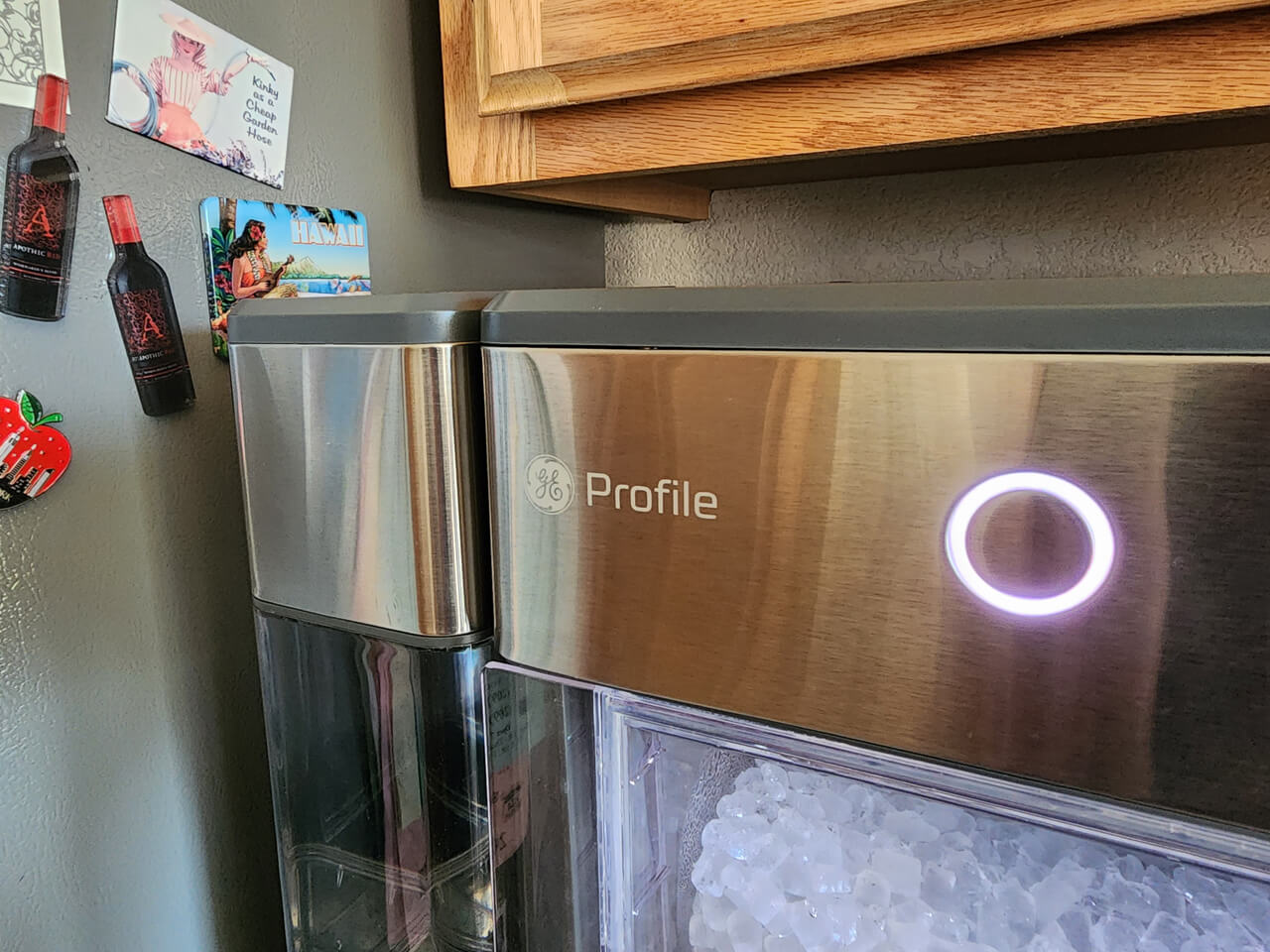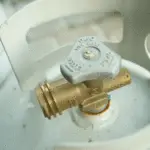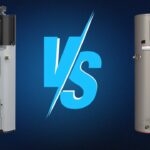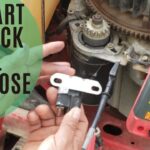To troubleshoot a GE refrigerator ice maker, first check the water supply line for kinks and ensure the freezer temperature is set between 0-5°F. Next, inspect the water filter and replace it if necessary.
Dealing with a malfunctioning GE refrigerator ice maker can be frustrating. Your ice maker might stop working for various reasons, from simple fixes like adjusting the freezer temperature to more complex issues such as a blocked water supply line. Understanding the common problems and how to address them quickly can save you time and avoid the inconvenience of being without ice.
This guide aims to provide straightforward troubleshooting tips to get your GE refrigerator’s ice maker back in working order. By following these suggestions, you can diagnose and potentially resolve the issue without needing professional help, ensuring your ice maker functions efficiently once again.

Credit: the-goodnerd.com
Identifying Common Ice Maker Issues
Is your GE refrigerator ice maker not working as expected? It’s frustrating when you can’t get ice for your drinks. This guide will help you identify common problems and offer quick diagnostics. Let’s dive into troubleshooting your GE ice maker.
Symptoms Of Malfunction
Ice makers can show various signs when they fail. Knowing these symptoms is key to a quick fix. Here are the most common:
- No ice production
- Small or incomplete cubes
- Ice tastes odd or has debris
- Ice maker makes loud noises
- Water leaks in or around the ice maker
Quick Diagnostic Tips
Start with these simple checks:
- Ensure the power switch is on
- Check for a water supply issue
- Inspect the fill tube for ice blockages
- Look for clogged filters
- Reset the ice maker
For more detailed diagnostics, follow these steps:
| Issue | Check | Action |
|---|---|---|
| No Ice | Freezer temperature | Set to 0°F (-18°C) |
| Small Cubes | Water line | Remove kinks |
| Odd Tasting Ice | Water filter | Replace if necessary |
| Loud Noises | Ice maker parts | Check for loose components |
| Leaks | Water lines and tray | Ensure proper alignment |
Remember, if these steps don’t resolve the issue, contact a professional. They can handle complex repairs safely.
Initial Steps Before Troubleshooting
When a GE refrigerator ice maker stops working, the fix might be easy. Before diving into troubleshooting, take these initial steps. These ensure safety and prepare for any needed repairs. Let’s get started with the right approach.
Safety Precautions
Always prioritize safety when fixing appliances. Here are key precautions:
- Unplug the fridge to prevent electric shock.
- Wear gloves to protect hands from sharp edges.
- Clear the work area to avoid trips and falls.
Tools Required For Repairs
Certain tools make the repair process smooth. Gather these tools:
| Tool Type | Use |
|---|---|
| Screwdrivers | Disassemble panels |
| Nut drivers | Remove bolts |
| Flashlight | Illuminates dark spaces |
| Multimeter | Test electrical components |
With safety measures in place and tools ready, troubleshooting can begin. Tackling GE refrigerator ice maker issues is now safer and more efficient.
Power And Connectivity Checks
Is your GE refrigerator ice maker on strike? It might be a power or connectivity issue. Let’s plug into some common fixes to get it back to work.
Ensuring Proper Power Supply
First, check the ice maker’s power. Is the refrigerator plugged in? Look for loose cords. A secure plug means power can flow.
- Check the outlet with a tester or plug in another device.
- Examine the cord for damage or wear. Replace if necessary.
- Verify the circuit breaker hasn’t tripped. Reset it if needed.
Verifying Electrical Connections
Next, let’s peek at the electrical connections. Loose or corroded wires can stop the ice maker.
- Turn off the fridge to ensure safety.
- Remove the ice maker’s cover to inspect wires.
- Look for any disconnected or corroded connections. Fix them with care.
Power issues can freeze an ice maker’s function. These checks can thaw out the problem. Try them before calling for help.
Water Supply Analysis
Let’s dive into the Water Supply Analysis for your GE refrigerator ice maker. A strong water supply means lots of ice. Weak water supply means trouble. We will check two main parts: the water line and water pressure.
Inspecting The Water Line
First, we need to look at the water line. This line brings water to your ice maker. Follow these steps:
- Find the water line behind your fridge.
- Check it for kinks or bends. These can block water flow.
- Look for leaks. Even a small leak can cause big problems.
- Make sure the valve is open. A closed valve stops water flow.
If you find any issues, fix them to get your ice maker working again.
Testing Water Pressure
Next, let’s test the water pressure. Good pressure is key for making ice. Here is how:
- Disconnect the water line from the fridge.
- Place the line in a bucket or a big bowl.
- Turn the water valve on. Watch how fast the water comes out.
If the water trickles out, the pressure is too low. You might need a plumber to fix this. If the water flows fast, your pressure is good.
Remember, always turn off the water supply before checking the line or pressure. This keeps you and your fridge safe.
Ice Maker Mechanism Inspection
When your GE refrigerator’s ice maker stops working, don’t worry. You can often find the problem yourself by checking its parts. One key step is the Ice Maker Mechanism Inspection. This process involves looking at different parts of the ice maker to find any issues. Let’s start by examining two important parts: the ejector blades and the control arm.
Evaluating The Ejector Blades
The ejector blades push the ice out of the ice maker. If they’re stuck or broken, the ice maker won’t work right. First, make sure your fridge is unplugged. This keeps you safe. Then, open the freezer and find the ice maker. Look closely at the blades. Are they blocked by ice? Use a plastic utensil to gently remove any ice. Never use metal tools; they can damage the blades. If the blades are not moving, they might be broken. In this case, you may need to replace them.
Assessing The Control Arm Position
The control arm is a big deal for your ice maker. It tells the machine when to make ice and when to stop. First, find the control arm. It’s a long, thin arm on the side or top of the ice maker. Make sure it’s in the down position. This position tells the ice maker to keep making ice. If the arm is up, it stops the ice maker. Sometimes, moving it up and down can fix the problem. If the arm won’t move or is broken, you might need a new one.
Checking these parts of your GE refrigerator’s ice maker can save you time and money. Always remember to be gentle and use the right tools. If these steps don’t fix the issue, it might be time to call a professional.

Credit: paradiseapplianceservice.com
Temperature Control In The Freezer
Are you facing issues with your GE refrigerator ice maker? A key factor might be the freezer temperature. Let’s dive into how temperature affects ice production and what you can do if your freezer isn’t cold enough.
Optimal Freezer Temperature For Ice Production
For a GE refrigerator ice maker to work efficiently, the freezer temperature must be just right. Ice makers need a cold environment to function properly. The optimal range is between 0°F and 5°F (-18°C to -15°C).
- Check the thermostat: Ensure it’s set within the ideal range.
- Use a thermometer: Verify the actual temperature inside.
- Avoid overpacking: This allows air to circulate and maintain a consistent temperature.
Troubleshooting Temperature Fluctuations
Temperature inconsistencies can prevent ice production. Here’s how to troubleshoot:
- Inspect the seals: Make sure the door seals are tight and clean.
- Examine the vents: Clear any blockages that might disrupt airflow.
- Check the coils: Dirty coils can cause cooling issues. Clean them regularly.
Remember to defrost the freezer if frost builds up. Excessive frost can lead to temperature problems.
If these steps don’t resolve the issue, contact a professional. They can diagnose and fix complex problems.
Filter And Water Valve Examination
When your GE refrigerator ice maker stops working, check the filter and water valve. These are common culprits. A clogged filter or faulty valve prevents ice production. Let’s tackle these issues step by step.
Replacing The Water Filter
A fresh water filter ensures clean ice. Here’s how to replace it:
- Locate the filter. It’s inside the refrigerator, usually in the upper right corner.
- Turn the filter to the left. This releases it.
- Pull the old filter out.
- Remove the protective cap from the new filter.
- Insert the new filter into the housing.
- Turn the filter to the right. This locks it in place.
- Reset the filter change indicator. This varies by model.
- Run two gallons of water through the dispenser. This clears the system.
Checking The Inlet Water Valve
The inlet water valve controls water flow to the ice maker. Follow these steps:
- Unplug the refrigerator. Safety first!
- Move the refrigerator for valve access.
- Locate the valve. It’s at the back, where the water line connects.
- Inspect the valve for damage or leaks.
- Test the valve with a multimeter. Ensure it has continuity.
- If faulty, replace the valve. Disconnect the water line and remove mounting screws.
- Install the new valve. Secure it with screws and reconnect the water line.
- Plug in the refrigerator. Check for proper water flow.
Advanced Diagnostics And Error Codes
Modern GE refrigerators come equipped with advanced diagnostic systems. These systems use error codes to signal specific issues. Understanding these codes is crucial for effective troubleshooting.
Interpreting Refrigerator Error Codes
Error codes appear on the refrigerator’s display panel. They indicate malfunctions within the fridge’s various components. Below is a list of common GE refrigerator error codes related to the ice maker:
- 0F 0F: Freezer defrost function issue
- 22 22: Ice maker sensor fault
- 25 E: Ice maker error
- 40 E: Ice fan problem
- 88 88: Full system reset required
Refer to the user manual for a complete list of codes. Perform the recommended actions for each code.
When To Seek Professional Assistance
Some issues require expert attention. Call a technician if:
- Multiple error codes flash simultaneously
- One error code persists after troubleshooting
- Ice maker stops working completely
Professional technicians can provide accurate diagnoses and repairs. They ensure your refrigerator runs smoothly again.
Maintenance Tips To Prevent Future Issues
Maintenance tips keep your GE refrigerator ice maker running smoothly. Proper care prevents future issues. Follow these guidelines to avoid common ice maker problems.
Regular Cleaning Recommendations
Clean your ice maker regularly for optimal performance. Dirt and frost can cause malfunctions. Here’s how to do it:
- Turn off the ice maker.
- Remove ice bin and wash with warm, soapy water.
- Wipe the ice maker with a soft cloth.
- Use a mild detergent for stubborn stains.
- Rinse thoroughly and dry before replacing the bin.
Preventive Measures For Ice Maker Care
Preventive care extends your ice maker’s life. Follow these simple steps:
| Task | Frequency |
|---|---|
| Inspect water filter | Every 6 months |
| Check water supply line | Annually |
| Look for frost buildup | Monthly |
| Ensure proper temperature | Continuously |
Replace filters as needed to maintain water flow. Keep the freezer at the right temperature to promote ice production. Avoid placing hot food near the ice maker to prevent frost.
Troubleshooting Other Ice Maker Components
When your GE refrigerator’s ice maker stops working, it’s important to check each component. Before calling for service, explore simple fixes that could get your ice maker running again.
Thermostat And Sensor Checks
The thermostat and sensors play a vital role in ice production. Ensure they function properly. Use a multimeter to test the thermostat’s continuity. Replace it if it fails the test. Sensors should also align correctly. Check for any error codes displayed on the refrigerator’s panel that might indicate sensor issues.
Motor And Gear Functionality
The motor and gear system drives the ice ejector arms. Listen for abnormal sounds that suggest a motor problem. Inspect the gears for wear or damage. A jammed gear can halt ice production. Unplug the fridge and remove any obstructions. If the motor is defective, it will need replacing.

Credit: m.youtube.com
Frequently Asked Questions
Why Is My Ge Ice Maker Not Working?
Troubleshooting a GE ice maker begins with checking for common issues such as a frozen water line, incorrect freezer temperature, or a clogged filter.
How Do I Reset My Ge Refrigerator Ice Maker?
Resetting a GE ice maker often involves turning the power switch off and on, or unplugging the refrigerator for 30 seconds before reconnecting.
Can A Ge Ice Maker Be Repaired?
Many GE ice maker problems are repairable, often requiring part replacements like a new water valve or ice maker assembly.
What Causes Ge Ice Maker To Leak Water?
Leaks in a GE ice maker may result from a faulty water inlet valve, an improper water line connection, or a blocked drain line.
How Often Should I Clean My Ge Ice Maker?
To ensure optimal performance, cleaning your GE ice maker every six months is recommended, including wiping down surfaces and using a cleaning solution.
Where Can I Find Ge Ice Maker Replacement Parts?
GE ice maker replacement parts are available through the official GE Appliances website, authorized dealers, and online marketplaces like Amazon.
Conclusion
Wrapping up, tackling issues with your GE refrigerator’s ice maker can be straightforward if you follow the right steps. Keep this guide handy for quick fixes and remember, regular maintenance prevents most problems. If challenges persist, seeking professional help is wise.
Enjoy your ice-cold beverages with confidence!





